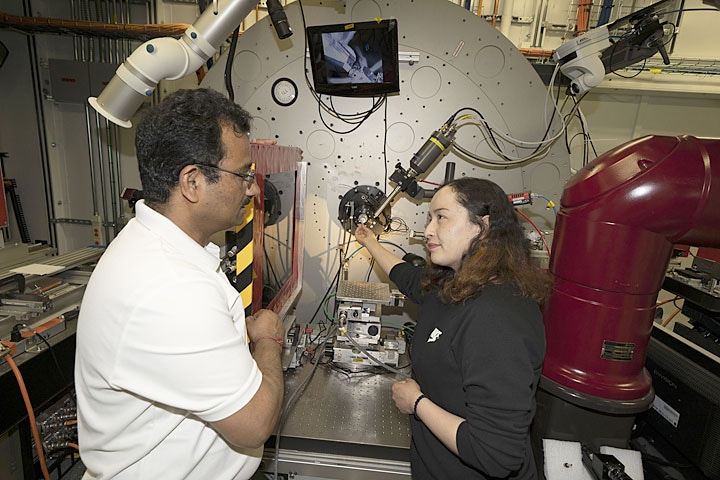May 31 2019
An innovative organic cathode material for lithium batteries has been developed by researchers at the U.S. Department of Energy’s (DOE) Brookhaven National Laboratory.
 Lead author Zulipiya Shadike (right) is pictured at NSLS-II’s XPD beamline with lead beamline scientist and co-author Sanjit Ghose (left). (Image credit: Brookhaven National Laboratory)
Lead author Zulipiya Shadike (right) is pictured at NSLS-II’s XPD beamline with lead beamline scientist and co-author Sanjit Ghose (left). (Image credit: Brookhaven National Laboratory)
When compared to conventional cathode materials used in lithium batteries, the new material—with sulfur at its core—is more cost-effective, energy-dense, and environmentally friendly. The results of the study have been reported in Advanced Energy Materials on April 10th, 2019.
Optimizing cathode materials
The technologies, ranging from electric vehicles to smartphones, have become fundamental to daily life run on lithium batteries. And with the growing demand for these kinds of products, researchers are exploring ways to improve cathode materials so as to enhance the overall performance of the lithium battery systems.
Commercialized lithium-ion batteries are used in small electronic devices; however, to accommodate long driving ranges for electric vehicles, their energy density needs to be higher. We are trying to develop new battery systems with a high energy density and stable performance.
Zulipiya Shadike, Study Lead Author and Research Associate, Chemistry Division, Brookhaven National Laboratory
Apart from solving the energy concerns of battery systems, Brookhaven researchers are exploring battery material designs that are more sustainable. In the quest for a cathode material that is sustainable and also offers a high energy density, the scientists ultimately selected a safe and abundantly available element—sulfur.
Sulfur can form a lot of bonds, which means it can hold on to more lithium and therefore have a greater energy density. Sulfur is also lighter than traditional elements in cathode materials, so if you make a battery out of sulfur, the battery itself would be lighter and the car it runs on could drive further on the same charge.
Adrian Hunt, Study Co-Author and Scientist, National Synchrotron Light Source II (NSLS-II)
National Synchrotron Light Source II (NSLS-II) is a DOE Office of Science User Facility at Brookhaven National Laboratory.
When developing the novel cathode material, the scientists chose an organodisulfide compound that contains only elements like oxygen, sulfur, hydrogen, and carbon, and not the heavy metals that are present in standard lithium batteries, which are known to be less environmentally friendly. However, despite being more energy dense and safer, sulfur batteries can pose other difficulties.
When a battery is charging or discharging, sulfur can form an undesirable compound that dissolves in the electrolyte and diffuses throughout the battery, causing an adverse reaction. We attempted to stabilize sulfur by designing a cathode material in which sulfur atoms were attached to an organic backbone.
Zulipiya Shadike, Study Lead Author and Research Associate, Chemistry Division, Brookhaven National Laboratory
X-rays reveal the details
Once the novel material was designed and developed by the research team in Brookhaven’s Chemistry Division, it was subsequently brought to NSLS-II to better figure out its mechanism of charge and discharge cycle. Utilizing NSLS-II’s ultrabright X-rays at two varied experimental stations—the In situ and Operando Soft X-ray Spectroscopy (IOS) beamline and the X-ray Powder Diffraction (XPD) beamline, the researchers were able to find out how certain elements in the organic cathode material supported its performance.
It can be difficult to study organic battery materials using synchrotron light sources because, compared to heavy metals, organic compounds are lighter and their atoms are less ordered, so they produce weak data. Fortunately, we have very high flux and high energy x-ray beams at NSLS-II that enable us to ‘see’ the abundance and activity of each element in a material, including lighter, less-ordered organic elements.
Sanjit Ghose, Study Co-Author and Lead Scientist, XPD Beamline, NSLS-II, Brookhaven National Laboratory
Ghose added, “Our colleagues in the chemistry department designed and synthesized the cathode material as per the theoretically predicted structure. To our surprise, our experimental observations matched the theoretically driven structure exactly.”
We used soft x-rays at IOS to directly probe the oxygen atom in the backbone and study its electronic structure, before and after the battery charged and discharged. We confirmed the carbonyl group—having a double bond between a carbon atom and an oxygen atom—not only plays a big role in improving the fast charge-discharge capability of the battery but also provides extra capacity.
Iradwikanari Waluyo, Study Co-Author and Lead Scientist, In situ and Operando Soft X-ray Spectroscopy, NSLS-II, Brookhaven National Laboratory
The outcomes from NSLS-II and supplementary experiments performed at the Canadian Light Source allowed the researchers to effectively confirm the charge-discharge capacity of the battery offered by the sulfur atoms. According to the researchers, this latest study offers a new method for enhancing the sulfur-based cathodes’ performance for high-performance lithium batteries.
DOE’s Office of Energy Efficiency and Renewable Energy supported the study, and DOE’s Office of Science supported operations at NSLS-II.